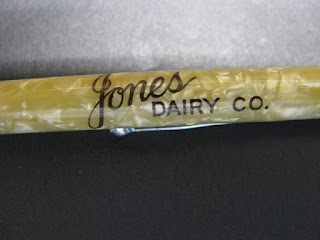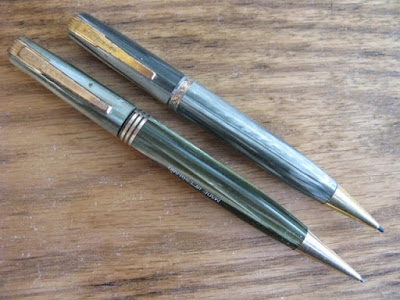Pencil: a pointed, rod-shaped instrument of wood, metal, etc., with a center or core of graphite or crayon, used for marking, writing and drawing.......... Ponder: to mentally weigh, deliberate, think deeply about, consider carefully.
Tuesday, November 26, 2019
Jones Dairy, Maker Unknown
It's a little odd to find in the family desk, a pencil from a dairy wholesaler. Irv Jones, of Jones Dairy in Des Moines, only sold his milk wholesale. I can't quite figure how our family would have acquired this pencil, but I'm pretty sure my grandfather was involved. He loved meeting people, and at one time worked for Flynn Dairy in Urbandale.
There is no maker marking on this cream-yellow marble pencil with the milk bottle cap. It is a 5 & 3/8 inch middle twist pencil, and the milk bottle pulls off. There's an eraser underneath. The silver-colored trim is in nice condition, but the friction-fit tube-drive mechanism is stripped, unfortunately.
It uses 1.0 mm lead, dating this to the early-to-mid 1930s. One possibility for the maker is the Quickpoint company of St. Louis, who made mostly advertising pencils.
If you know more, please leave a comment.
Friday, October 25, 2019
A Surprise: Shaw - Barton
Before Anderson - Erickson Dairy ordered their advertiser pencils from Sheaffer, what a surprise!, they used Shaw - Barton. From the family desk drawer:
Shaw - Barton started making pencils in 1940 when they purchased a calendar company (making other specialty advertising items, as well) in their hometown of Coshocton, in east central Ohio. This is a slim 1940s middle twist pencil, using the recently introduced slim lead (0.9 mm). It is 5 inches long.
Shaw Barton is stamped into the top of the slightly rusty clip--you need a magnifying glass to see it.
The top "jewel" is crackled transparent yellow plastic, maybe Lucite, an acrylic-based plastic.
Other family A-E pencils can be seen here: More Sheaffers in the Waterman Family Desk
Shaw - Barton started making pencils in 1940 when they purchased a calendar company (making other specialty advertising items, as well) in their hometown of Coshocton, in east central Ohio. This is a slim 1940s middle twist pencil, using the recently introduced slim lead (0.9 mm). It is 5 inches long.
The top "jewel" is crackled transparent yellow plastic, maybe Lucite, an acrylic-based plastic.
Other family A-E pencils can be seen here: More Sheaffers in the Waterman Family Desk
Sunday, October 6, 2019
Redipoint Advertisers from the Family Desk
Although I don't usually collect pencils with advertising, these were foisted upon me. They were in the family desk drawers and pencil cups, and it just didn't seem right to toss them. They have a connection to places my great aunt lived and worked. From the time capsule of family history, so to speak.
The left-handedness of this pencil refers to the way the ad was printed on the pencil, so it could be read if you held the pencil in your left hand. It originated with the Comer Motor Repair Shop in Granger, Iowa. Slightly later, the shop went right-handed with this Redipoint.
It has the same nose drive mechanism, the same tortoise shell marble, but has a white center and new advertising gimmick: the shop is your "doctor of motors." A repairman is using his stethoscope to diagnose a convertible's ailment.
This 1930s Redipoint nosedrive pencil has cream and tortoise shell celluloid marbles and gold-toned trimmings. The Redipoint company story is complicated and even scandalous! You can read all about it on Jon Veeley's pencil blog linked above.
This final Redipoint has an eight-ball telephone dialer end cap. It features the same nose drive mechanism, three-part construction, and has the same clip as the other Redipoints above. The plastics are all solid colors, and the advertising comes from an Ogden, Iowa, feedstore which cautions its customers not to "get behind the eight ball" and run out of feed. It ends with, "Thank you for your cooperation." You'd almost think the farm animals had written the text!
Friday, May 10, 2019
Jade Green
Do you like a hefty green marble pencil? If so, you'll like this Eclipse bell top from about 1923.
You can see at once why this marble is called "jade." The jade bell top is 5 inches, with gold metal fittings. It has the script writing on the clip, along with the 1923 patent date (9/18/23) in teeny numerals, as well as Eclipse in an oval, inside a circle--also teeny--at the top of the clip.
It's a cream and green marble, with darker and lighter greens. I wonder if Irish Republicans living in New York in 1923, one year after Irish independence, bought this pencil for themselves or their families at home in Erin, the Emerald Isle. If so, most appropriate!
A couple of years later, Sheaffer introduced their "Titan" bell top with a similar marble. The Titan was another 1/4 inch longer, but the jade was a bit paler colored, and more of a yellow-green. Here they are together.
A couple of years later, Sheaffer introduced their "Titan" bell top with a similar marble. The Titan was another 1/4 inch longer, but the jade was a bit paler colored, and more of a yellow-green. Here they are together.
In 1923, there was also this new perfume:
Très à la mode.
Tuesday, April 23, 2019
The Last Watermans of the English-Speaking World
The American Waterman company ended production in the late 1950s. More than 20 years later it was revived, but in France, where the company still makes writing instruments. In England, the company may have continued until the French-based Waterman's took over. These three examples are the end of the story for both locations.
The green striated marble with gold trim is an English-made middle twist pencil with "military" clip and a simple "Made In England" impressed mark; it lacks the Waterman name on the marble.
At almost 5 inches, it is larger than the earlier British-made Waterman of 4.25 inches. Possibly these were meant to be a man's and a lady's pencil. The more decorative band on the smaller pencil could support that idea, too. They are the "Commando" model.
On the other side of the pond, the Taperite model pen and pencil were second-to-last of the American-made products for Waterman's. This black plastic, gold cap and tip, 5 inch Taperite pencil is slim and uses the 0.9 mm "thin" lead. It has a lightweight, even flimsy feel, and is a nose-drive mechanism with a line of grip on the tip. An eraser is under the cap. There is no other marking than the name on the clip.
At almost 5 inches, it is larger than the earlier British-made Waterman of 4.25 inches. Possibly these were meant to be a man's and a lady's pencil. The more decorative band on the smaller pencil could support that idea, too. They are the "Commando" model.
On the other side of the pond, the Taperite model pen and pencil were second-to-last of the American-made products for Waterman's. This black plastic, gold cap and tip, 5 inch Taperite pencil is slim and uses the 0.9 mm "thin" lead. It has a lightweight, even flimsy feel, and is a nose-drive mechanism with a line of grip on the tip. An eraser is under the cap. There is no other marking than the name on the clip.
The last Waterman is this pencil made to accompany the "Cartridge Fill" pen of the late 1950s, another ho-hum model name. You have to wonder if a more exciting name might not have helped the company survive a few more years in the US. Sheaffer went on longer with their "Skripsert" cartridge-filled pen and matching pencil, but who knows?
At least this one feels more substantial than the Taperite. It is 5.25 inches and uses 0.9 lead. The eraser is under the cap. The modern-looking clip is gold-trimmed while the cap is silver, over a black plastic barrel. Waterman's and Made in USA is inscribed on the base of the cap.
Au revoir!
Friday, April 5, 2019
Friday, March 29, 2019
An Early DeWitt-La France Superite
It is a sterling silver-plated 4 inch rear-drive pencil with curlicue decoration on the cap, which pulls straight off for an eraser enclosure. It can be dated to 1919-1922 from the "STERLING PATENT PENDING" inscription. It is also marked "Superite, MAKERS DeWitt-LaFrance Co.,CAMBRIDGE, MASS." One hundred years later, it still works well.
I like to think of these two entrepreneurs working in Cambridge, a place I know and appreciate. It is the quintessential university/college town, with outlets for all the intellectual and cultural pursuits one could wish for, as well as much more. There is literally ivy on the ivy league university buildings.
Harvard is there, as well as Radcliffe--history oozes from every paving stone. Daily walking over those stones by the old cemetery, an earlier idea of mortality is thrust upon you. Memento mori!
Perhaps one of the Radcliffe students purchased and used this pencil in Cambridge, wearing it on a ribbon to class.
 |
| Radcliffe class of 1923 |
For my earlier blog on the DeWitt-La France Company, use this link:
Subscribe to:
Posts (Atom)





































